Mo Li
Sculptor: Empowering LLMs with Cognitive Agency via Active Context Management
Aug 06, 2025Abstract:Large Language Models (LLMs) suffer from significant performance degradation when processing long contexts due to proactive interference, where irrelevant information in earlier parts of the context disrupts reasoning and memory recall. While most research focuses on external memory systems to augment LLMs' capabilities, we propose a complementary approach: empowering LLMs with Active Context Management (ACM) tools to actively sculpt their internal working memory. We introduce Sculptor, a framework that equips LLMs with three categories of tools: (1) context fragmentation, (2) summary, hide, and restore, and (3) intelligent search. Our approach enables LLMs to proactively manage their attention and working memory, analogous to how humans selectively focus on relevant information while filtering out distractions. Experimental evaluation on information-sparse benchmarks-PI-LLM (proactive interference) and NeedleBench Multi-Needle Reasoning-demonstrates that Sculptor significantly improves performance even without specific training, leveraging LLMs' inherent tool calling generalization capabilities. By enabling Active Context Management, Sculptor not only mitigates proactive interference but also provides a cognitive foundation for more reliable reasoning across diverse long-context tasks-highlighting that explicit context-control strategies, rather than merely larger token windows, are key to robustness at scale.
MMSI-Bench: A Benchmark for Multi-Image Spatial Intelligence
May 29, 2025Abstract:Spatial intelligence is essential for multimodal large language models (MLLMs) operating in the complex physical world. Existing benchmarks, however, probe only single-image relations and thus fail to assess the multi-image spatial reasoning that real-world deployments demand. We introduce MMSI-Bench, a VQA benchmark dedicated to multi-image spatial intelligence. Six 3D-vision researchers spent more than 300 hours meticulously crafting 1,000 challenging, unambiguous multiple-choice questions from over 120,000 images, each paired with carefully designed distractors and a step-by-step reasoning process. We conduct extensive experiments and thoroughly evaluate 34 open-source and proprietary MLLMs, observing a wide gap: the strongest open-source model attains roughly 30% accuracy and OpenAI's o3 reasoning model reaches 40%, while humans score 97%. These results underscore the challenging nature of MMSI-Bench and the substantial headroom for future research. Leveraging the annotated reasoning processes, we also provide an automated error analysis pipeline that diagnoses four dominant failure modes, including (1) grounding errors, (2) overlap-matching and scene-reconstruction errors, (3) situation-transformation reasoning errors, and (4) spatial-logic errors, offering valuable insights for advancing multi-image spatial intelligence. Project page: https://runsenxu.com/projects/MMSI_Bench .
Advancing Mobile GUI Agents: A Verifier-Driven Approach to Practical Deployment
Mar 21, 2025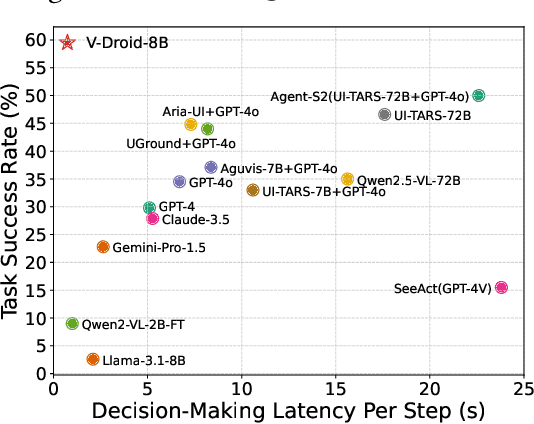


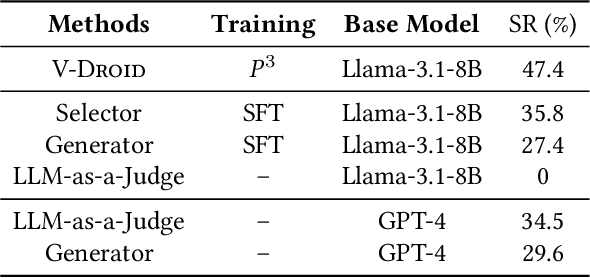
Abstract:We propose V-Droid, a mobile GUI task automation agent. Unlike previous mobile agents that utilize Large Language Models (LLMs) as generators to directly generate actions at each step, V-Droid employs LLMs as verifiers to evaluate candidate actions before making final decisions. To realize this novel paradigm, we introduce a comprehensive framework for constructing verifier-driven mobile agents: the discretized action space construction coupled with the prefilling-only workflow to accelerate the verification process, the pair-wise progress preference training to significantly enhance the verifier's decision-making capabilities, and the scalable human-agent joint annotation scheme to efficiently collect the necessary data at scale. V-Droid sets a new state-of-the-art task success rate across several public mobile task automation benchmarks: 59.5% on AndroidWorld, 38.3% on AndroidLab, and 49% on MobileAgentBench, surpassing existing agents by 9.5%, 2.1%, and 9%, respectively. Furthermore, V-Droid achieves an impressively low latency of 0.7 seconds per step, making it the first mobile agent capable of delivering near-real-time, effective decision-making capabilities.
AutoIOT: LLM-Driven Automated Natural Language Programming for AIoT Applications
Mar 07, 2025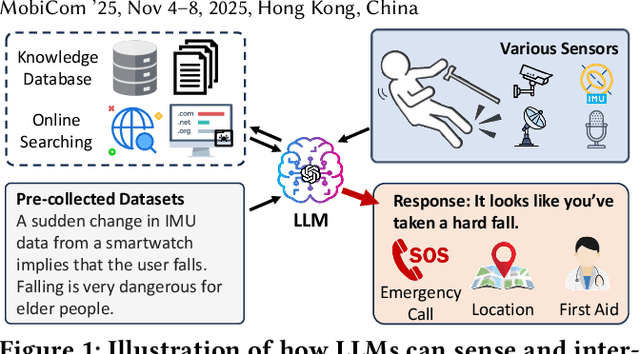

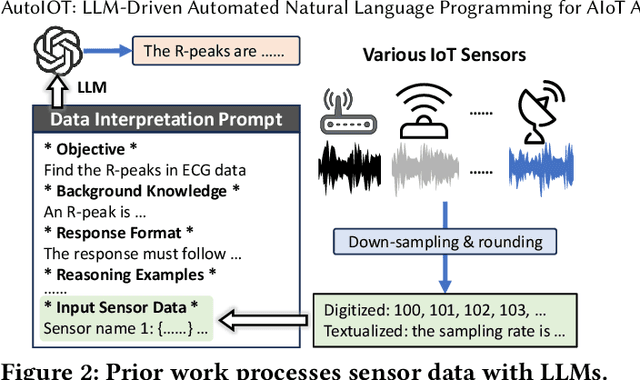
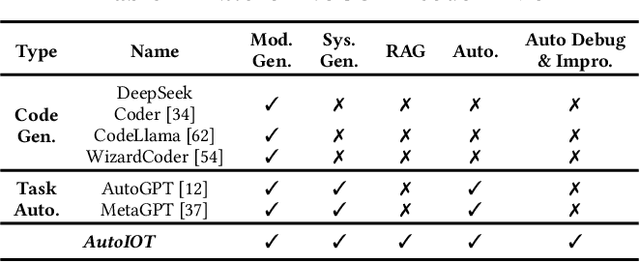
Abstract:The advent of Large Language Models (LLMs) has profoundly transformed our lives, revolutionizing interactions with AI and lowering the barrier to AI usage. While LLMs are primarily designed for natural language interaction, the extensive embedded knowledge empowers them to comprehend digital sensor data. This capability enables LLMs to engage with the physical world through IoT sensors and actuators, performing a myriad of AIoT tasks. Consequently, this evolution triggers a paradigm shift in conventional AIoT application development, democratizing its accessibility to all by facilitating the design and development of AIoT applications via natural language. However, some limitations need to be addressed to unlock the full potential of LLMs in AIoT application development. First, existing solutions often require transferring raw sensor data to LLM servers, which raises privacy concerns, incurs high query fees, and is limited by token size. Moreover, the reasoning processes of LLMs are opaque to users, making it difficult to verify the robustness and correctness of inference results. This paper introduces AutoIOT, an LLM-based automated program generator for AIoT applications. AutoIOT enables users to specify their requirements using natural language (input) and automatically synthesizes interpretable programs with documentation (output). AutoIOT automates the iterative optimization to enhance the quality of generated code with minimum user involvement. AutoIOT not only makes the execution of AIoT tasks more explainable but also mitigates privacy concerns and reduces token costs with local execution of synthesized programs. Extensive experiments and user studies demonstrate AutoIOT's remarkable capability in program synthesis for various AIoT tasks. The synthesized programs can match and even outperform some representative baselines.
Condor: Enhance LLM Alignment with Knowledge-Driven Data Synthesis and Refinement
Jan 21, 2025



Abstract:The quality of Supervised Fine-Tuning (SFT) data plays a critical role in enhancing the conversational capabilities of Large Language Models (LLMs). However, as LLMs become more advanced, the availability of high-quality human-annotated SFT data has become a significant bottleneck, necessitating a greater reliance on synthetic training data. In this work, we introduce Condor, a novel two-stage synthetic data generation framework that incorporates World Knowledge Tree and Self-Reflection Refinement to produce high-quality SFT data at scale. Our experimental results demonstrate that a base model fine-tuned on only 20K Condor-generated samples achieves superior performance compared to counterparts. The additional refinement stage in Condor further enables iterative self-improvement for LLMs at various scales (up to 72B), validating the effectiveness of our approach. Furthermore, our investigation into the scaling for synthetic data in post-training reveals substantial unexplored potential for performance improvements, opening promising avenues for future research.
AutoLife: Automatic Life Journaling with Smartphones and LLMs
Dec 23, 2024Abstract:This paper introduces a novel mobile sensing application - life journaling - designed to generate semantic descriptions of users' daily lives. We present AutoLife, an automatic life journaling system based on commercial smartphones. AutoLife only inputs low-cost sensor data (without photos or audio) from smartphones and can automatically generate comprehensive life journals for users. To achieve this, we first derive time, motion, and location contexts from multimodal sensor data, and harness the zero-shot capabilities of Large Language Models (LLMs), enriched with commonsense knowledge about human lives, to interpret diverse contexts and generate life journals. To manage the task complexity and long sensing duration, a multilayer framework is proposed, which decomposes tasks and seamlessly integrates LLMs with other techniques for life journaling. This study establishes a real-life dataset as a benchmark and extensive experiment results demonstrate that AutoLife produces accurate and reliable life journals.
Expanding Deep Learning-based Sensing Systems with Multi-Source Knowledge Transfer
Dec 05, 2024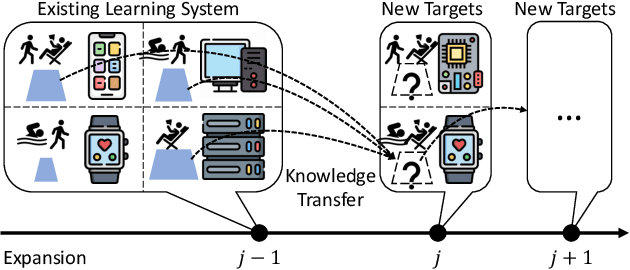


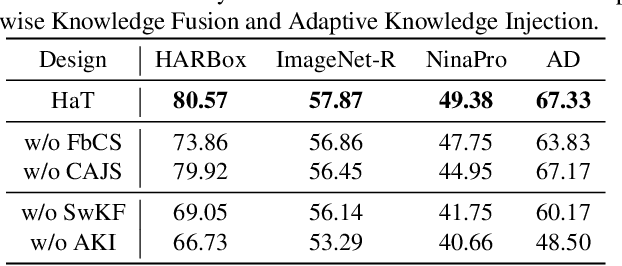
Abstract:Expanding the existing sensing systems to provide high-quality deep learning models for more domains, such as new users or environments, is challenged by the limited labeled data and the data and device heterogeneities. While knowledge distillation methods could overcome label scarcity and device heterogeneity, they assume the teachers are fully reliable and overlook the data heterogeneity, which prevents the direct adoption of existing models. To address this problem, this paper proposes an efficient knowledge transfer framework, HaKT, to expand sensing systems. It first selects multiple high-quality models from the system at a low cost and then fuses their knowledge by assigning sample-wise weights to their predictions. Later, the fused knowledge is selectively injected into the customized models for new domains based on the knowledge quality. Extensive experiments on different tasks, modalities, and settings show that HaKT outperforms stat-of-the-art baselines by at most 16.5% accuracy and saves up to 39% communication traffic.
Advancing Multi-Modal Sensing Through Expandable Modality Alignment
Jul 25, 2024Abstract:Sensing technology is widely used for comprehending the physical world, with numerous modalities explored in past decades. While there has been considerable work on multi-modality learning, they all require data of all modalities be paired. How to leverage multi-modality data with partially pairings remains an open problem. To tackle this challenge, we introduce the Babel framework, encompassing the neural network architecture, data preparation and processing, as well as the training strategies. Babel serves as a scalable pre-trained multi-modal sensing neural network, currently aligning six sensing modalities, namely Wi-Fi, mmWave, IMU, LiDAR, video, and depth. To overcome the scarcity of complete paired data, the key idea of Babel involves transforming the N-modality alignment into a series of two-modality alignments by devising the expandable network architecture. This concept is also realized via a series of novel techniques, including the pre-trained modality tower that capitalizes on available single-modal networks, and the adaptive training strategy balancing the contribution of the newly incorporated modality with the previously established modality alignment. Evaluation demonstrates Babel's outstanding performance on eight human activity recognition datasets, compared to various baselines e.g., the top multi-modal sensing framework, single-modal sensing networks, and multi-modal large language models. Babel not only effectively fuses multiple available modalities (up to 22% accuracy increase), but also enhance the performance of individual modality (12% averaged accuracy improvement). Case studies also highlight exciting application scenarios empowered by Babel, including cross-modality retrieval (i.e., sensing imaging), and bridging LLM for sensing comprehension.
NeedleBench: Can LLMs Do Retrieval and Reasoning in 1 Million Context Window?
Jul 16, 2024Abstract:In evaluating the long-context capabilities of large language models (LLMs), identifying content relevant to a user's query from original long documents is a crucial prerequisite for any LLM to answer questions based on long text. We present NeedleBench, a framework consisting of a series of progressively more challenging tasks for assessing bilingual long-context capabilities, spanning multiple length intervals (4k, 8k, 32k, 128k, 200k, 1000k, and beyond) and different depth ranges, allowing the strategic insertion of critical data points in different text depth zones to rigorously test the retrieval and reasoning capabilities of models in diverse contexts. We use the NeedleBench framework to assess how well the leading open-source models can identify key information relevant to the question and apply that information to reasoning in bilingual long texts. Furthermore, we propose the Ancestral Trace Challenge (ATC) to mimic the complexity of logical reasoning challenges that are likely to be present in real-world long-context tasks, providing a simple method for evaluating LLMs in dealing with complex long-context situations. Our results suggest that current LLMs have significant room for improvement in practical long-context applications, as they struggle with the complexity of logical reasoning challenges that are likely to be present in real-world long-context tasks. All codes and resources are available at OpenCompass: https://github.com/open-compass/opencompass.
Penetrative AI: Making LLMs Comprehend the Physical World
Oct 14, 2023



Abstract:Recent developments in Large Language Models (LLMs) have demonstrated their remarkable capabilities across a range of tasks. Questions, however, persist about the nature of LLMs and their potential to integrate common-sense human knowledge when performing tasks involving information about the real physical world. This paper delves into these questions by exploring how LLMs can be extended to interact with and reason about the physical world through IoT sensors and actuators, a concept that we term "\textit{Penetrative AI}". The paper explores such an extension at two levels of LLMs' ability to penetrate into the physical world via the processing of sensory signals. Our preliminary findings indicate that LLMs, with ChatGPT being the representative example in our exploration, have considerable and unique proficiency in employing the knowledge they learned during training for interpreting IoT sensor data and reasoning over them about tasks in the physical realm. Not only this opens up new applications for LLMs beyond traditional text-based tasks, but also enables new ways of incorporating human knowledge in cyber-physical systems.
 Add to Chrome
Add to Chrome Add to Firefox
Add to Firefox Add to Edge
Add to Edge